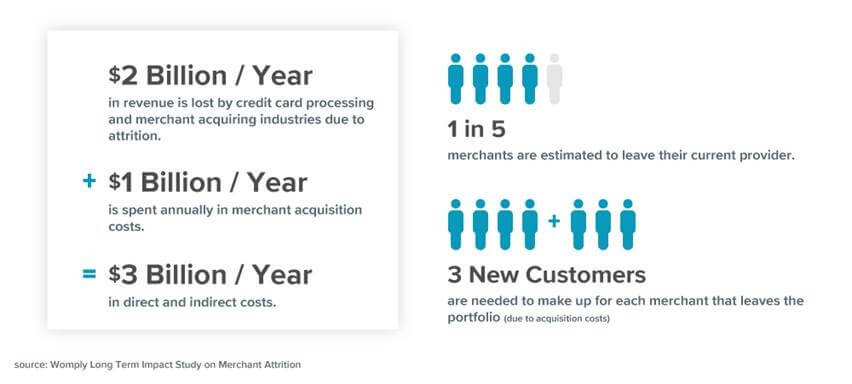Do you have the tools and resources to address.
Good, old-fashioned customer service to cut down on merchant attrition has been part of the approach by merchant processors and ISO’s for years. But that is long overdue for an update.
A newer concept is to aggregate customer data from various sources prior to any real problems surfacing to get a better handle on what merchant clients think of their payment’s services.
Attrition is an ongoing problem that costs merchant acquirers and ISO’s $2 billion a year in losses, plus another $1 billion per year spent to replace the merchants they have lost.
Often the replacement merchants are acquired with less favorable pricing, which has led to a steady decline in gross margins over the past few years.
According to Goldman Sachs Equity Research, “The industry continues to face significant pricing headwinds as a result of the relatively commoditized nature of merchant processing services”.

We’ve all had customers we thought were satisfied, and the next month they’re off our books and we don’t know why. Your customers are under no obligation to tell you why they replaced you.
In fact, they have no incentive to give you feedback. Why would customers risk your defensiveness? It’s easier for customers to disappear than tell you what they don’t like about your products or services.
It’s fine to get fired by your customers. You probably know you could make more money, with fewer headaches, if certain customers would take their business elsewhere.
It’s not fine, nor is it necessary, to be surprised by customer defections. Almost every customer defection is predictable and preventable.
Merchant processors and ISO’s that focus more on acquiring new customers than on keeping existing clients are losing out on the power of predictive analytics that can identify the pain points in their merchant relationship.
I often hear customers and prospects say that Price is the only factor in attrition.
How far from the truth, customer service, technical support, end of day balancing issues, chargebacks, industry specialization, seasonality, POS devices, or because a competitor promises a better or more complete solution are just some of the reasons for attrition.
There are new data tools and merchant management dashboards and retention predictive models to help processors and ISO’s attempt to lower the national average of 12% to 15% attrition rates or give some hope to those facing 25% to 30% turnover in their portfolios. But new tools can go unused in an industry that has traditionally failed to address client concerns quickly and understand the ramifications of losing an account. When it comes to Customer Analytics, a lack of customer data is not the issue.
Rather, it’s what organizations do with this data. To gain a complete understanding of your customers, you need to turn data into insight, and action. You also need to present results in a meaningful way so your first responders can use them to improve service, personalize marketing and drive profitability. Contact us today for a no obligation consultation and discussion. Over the past 10 years we have developed a range of merchant predictive retention models for merchant processors.

